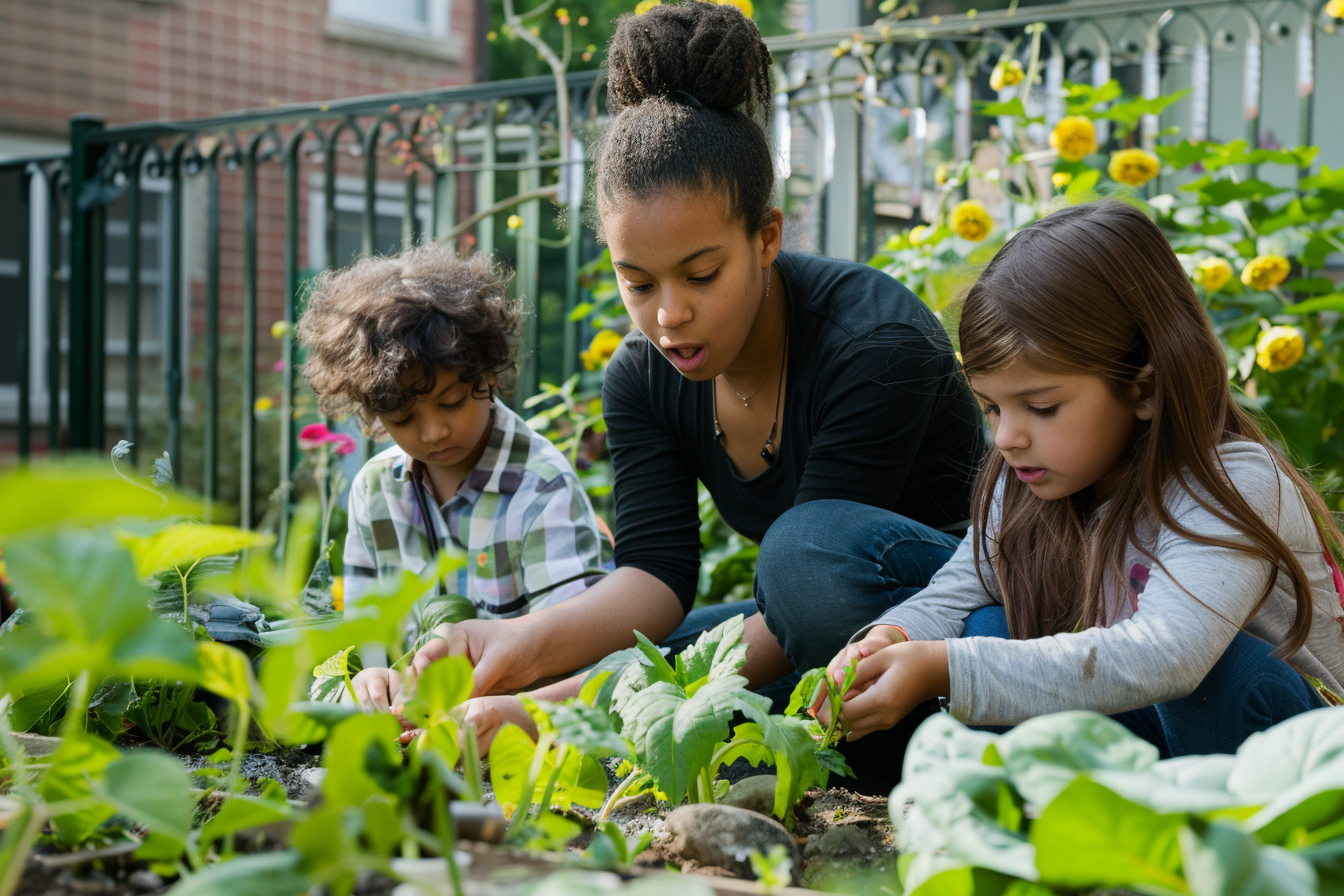Sustainable Education: The Power of School Gardens and Agricultural Programs
Discover how school gardens and agricultural education cultivate sustainability, hands-on STEM skills, and healthier students.

Imagine a school where students eagerly participate in hands-on activities that teach them about science, nutrition, and the environment. School gardens and agricultural education programs can turn this vision into reality, creating vibrant learning environments where students connect with nature and each other. As interest in sustainable living and experiential learning grows, these programs are becoming increasingly essential.
School gardens provide outdoor classrooms where students grow plants, learn about ecosystems, and understand the importance of agriculture. Agricultural education extends these lessons, incorporating broader topics like food production, environmental science, and nutrition. By engaging students in real-world activities, these programs enhance academic learning and promote essential life skills.
We will explore the numerous benefits of school gardens and agricultural education, practical steps for implementation, and inspiring case studies. Discover how integrating these programs can transform your school, foster environmental stewardship, and cultivate a love for learning among students. Dive in to learn more about the impact of school gardens and agricultural education on student development.
Understanding School Gardens and Agricultural Education
School gardens and agricultural education programs integrate hands-on learning with academic subjects, teaching students about gardening, ecology, and sustainable living. School gardens are outdoor classrooms where students grow plants, learn about ecosystems, and understand the importance of agriculture. Agricultural education extends these lessons, incorporating broader topics like nutrition, environmental science, and food production.
Historically, these programs have roots in early 20th-century education reforms that emphasized experiential learning and outdoor activities. Over time, school gardens have evolved to include innovative approaches such as hydroponics and urban gardening, reflecting advances in agricultural science and technology.
Enjoy science fiction? Check out my space books HERE on Amazon!
Incorporating school gardens and agricultural education into the curriculum provides students with practical skills and knowledge. These programs not only enhance academic learning but also promote environmental stewardship, healthy eating habits, and social responsibility. By engaging students in hands-on activities, schools can create a dynamic and enriching educational experience that connects students to the natural world.
Benefits of School Gardens and Agricultural Education
School gardens and agricultural education offer numerous benefits for students' academic, personal, and social development. Here are some key advantages:
- Hands-On Learning: Enhancing student engagement through experiential education. Students apply classroom knowledge in real-world settings, deepening their understanding of subjects like science, math, and nutrition.
- Environmental Stewardship: Teaching sustainability and ecological responsibility. Gardening activities foster an appreciation for nature and encourage environmentally friendly practices.
- Improved Nutrition and Health: Encouraging healthy eating habits through gardening. Students learn where their food comes from and are more likely to eat fruits and vegetables they have grown themselves.
- Social and Emotional Development: Building teamwork, responsibility, and a sense of accomplishment. Working together in the garden helps students develop communication skills, cooperation, and a sense of community.
These benefits highlight the importance of integrating school gardens and agricultural education into the curriculum. By providing hands-on learning experiences, schools can support students' academic achievement and foster lifelong skills and values.
Types of School Garden Programs
There are various types of school garden programs, each offering unique learning opportunities and benefits. Here are some effective models:
- Vegetable and Herb Gardens: Growing edible plants to learn about nutrition and ecology. These gardens teach students about plant biology, food production, and healthy eating.
- Pollinator Gardens: Creating habitats for bees, butterflies, and other pollinators to study ecosystems. These gardens help students understand the importance of pollinators in food production and biodiversity.
- Hydroponic and Indoor Gardens: Innovative gardening techniques for urban or space-limited schools. Hydroponic systems allow students to grow plants without soil, demonstrating modern agricultural methods and sustainability.
- Orchards and Fruit Gardens: Long-term projects involving the cultivation of fruit trees and bushes. These gardens teach patience and long-term planning, as students care for plants over several years.
- Cultural Gardens: Growing plants significant to various cultures to teach diversity and global awareness. These gardens promote understanding and respect for different cultural practices and traditions.
These types of school garden programs can be tailored to fit different educational contexts, providing flexible and impactful support for students' learning and development.
Implementing School Gardens and Agricultural Education
Implementing school gardens and agricultural education requires careful planning and preparation. Start by setting clear goals for the program, such as enhancing science education or promoting healthy eating. Select suitable garden sites and involve the community in the planning process to ensure support and resources.
Curriculum integration is essential for the success of these programs. Align garden activities with educational standards and learning objectives to reinforce classroom lessons. Incorporate subjects like biology, ecology, and nutrition into the gardening curriculum to provide a comprehensive educational experience.
Teacher training and support are crucial. Provide professional development opportunities focused on gardening techniques, curriculum integration, and classroom management in outdoor settings. Equip teachers with the knowledge and confidence to lead successful garden projects.
Maintenance and sustainability are key to the long-term success of school gardens. Develop a maintenance plan that includes regular care, student involvement, and community support. Use sustainable practices, such as composting and water conservation, to teach students about environmental responsibility and ensure the garden's longevity.
By following these steps, schools can successfully implement school gardens and agricultural education programs, creating a dynamic learning environment that benefits all students.
Overcoming Challenges in School Gardens and Agricultural Education
Implementing school gardens and agricultural education can present challenges, but with thoughtful strategies, these can be effectively managed. Limited space and resources are common obstacles. To address this, use creative solutions such as container gardening, vertical gardens, or partnering with local parks and community gardens.
Seasonal and climate considerations can also pose difficulties. Adapt gardening practices to suit your local climate and growing seasons. Use greenhouses or indoor gardening techniques to extend the growing season and provide year-round learning opportunities.
Gaining buy-in from stakeholders is crucial. Communicate the benefits of school gardens to parents, administrators, and the community. Share success stories and research highlighting improved student outcomes, such as increased academic achievement, better nutrition, and enhanced social skills.
By proactively addressing these challenges, schools can create effective and sustainable school garden programs that provide valuable educational experiences for students.
Case Studies
Implementing school gardens and agricultural education has led to impressive outcomes in various educational settings. Here are three case studies that highlight the impact of these programs:
Case Study 1: A Successful Vegetable Garden Program in an Elementary School
At an elementary school in Oregon, a vegetable garden was established to teach students about nutrition and ecology. Each class had its own plot, and students participated in planting, tending, and harvesting crops. Over the school year, students showed increased interest in healthy eating and a better understanding of plant biology. The garden became a central part of the school's curriculum, enhancing science and health education.
Case Study 2: Pollinator Garden Initiative Boosting Biodiversity in a Middle School
A middle school in Florida created a pollinator garden to support local biodiversity and teach students about ecosystems. The garden included a variety of native plants that attract bees, butterflies, and other pollinators. Students conducted research projects and monitored the garden's impact on local wildlife. The initiative increased students' environmental awareness and fostered a sense of responsibility for protecting their local ecosystem.
Case Study 3: High School Hydroponic Garden Integrating STEM Education
In a high school in New York, a hydroponic garden was set up to integrate STEM (Science, Technology, Engineering, and Mathematics) education. Students learned about modern agricultural techniques, plant biology, and sustainability through hands-on experience with hydroponic systems. The project also included lessons on data collection and analysis, enhancing students' research skills. The hydroponic garden provided a practical and engaging way to teach complex scientific concepts.
Practical Tips for Teachers
Implementing school gardens and agricultural education can be straightforward with these practical tips:
- Start Small: Begin with manageable projects and gradually expand as you gain experience and resources.
- Leverage Community Resources: Partner with local gardeners, agricultural experts, and organizations to gain knowledge and support.
- Encourage Student Leadership: Involve students in planning, planting, and maintaining the garden, giving them ownership and a sense of responsibility.
- Utilize Grants and Funding Opportunities: Seek financial support from grants, fundraising, and community donations to fund garden projects.
- Integrate with Curriculum: Align garden activities with educational standards and learning objectives to reinforce classroom lessons.
- Create a Maintenance Plan: Develop a schedule for garden care that includes regular student and community involvement to ensure sustainability.
- Promote Environmental Stewardship: Use the garden as a platform to teach sustainable practices like composting, water conservation, and organic gardening.
By following these tips, teachers can create effective and enjoyable school garden programs that enhance student learning and promote environmental stewardship.
Future Trends in School Gardens and Agricultural Education
The future of school gardens and agricultural education is evolving, with new trends enhancing their reach and impact. One significant trend is the integration of technology. Using apps, sensors, and data collection tools can enhance learning by providing real-time information and interactive experiences.
Urban agriculture initiatives are also gaining traction. Expanding agricultural education in urban environments includes rooftop gardens, community plots, and vertical farming, making gardening accessible even in space-limited areas.
Check out our engaging printable posters. CLICK HERE to explore!
Global connections are another key trend. Linking school garden projects with international initiatives promotes global awareness and cultural exchange. Students can learn about different agricultural practices worldwide and share their experiences with peers globally.
By embracing these future trends, schools can continue to innovate and expand their school garden and agricultural education programs, ensuring all students have access to effective and engaging learning experiences that connect them to the natural world and global community.
Conclusion
School gardens and agricultural education programs offer invaluable opportunities for hands-on learning, environmental stewardship, and personal development. By integrating these programs into the curriculum, schools can provide students with practical skills and knowledge that extend beyond the classroom. These initiatives promote healthier lifestyles, foster teamwork and responsibility, and enhance academic achievement through experiential learning.
Addressing challenges and leveraging community resources are essential for the successful implementation of these programs. Embracing future trends like technology integration, urban agriculture, and global connections can further enhance their impact. Educators are encouraged to adopt and adapt these innovative approaches, creating enriching educational experiences that inspire students and foster a lifelong appreciation for nature and sustainability.
Check out some of my latest science fiction books HERE on Amazon!
Transform your classroom into an inspiring and vibrant learning space with our beautifully designed printable posters! Perfect for engaging your students and enhancing your teaching environment, our poster bundles cover everything from historical philosophers to animals. CLICK HERE to explore our exclusive collections on Teachers Pay Teachers and give your students the motivational boost they need!
